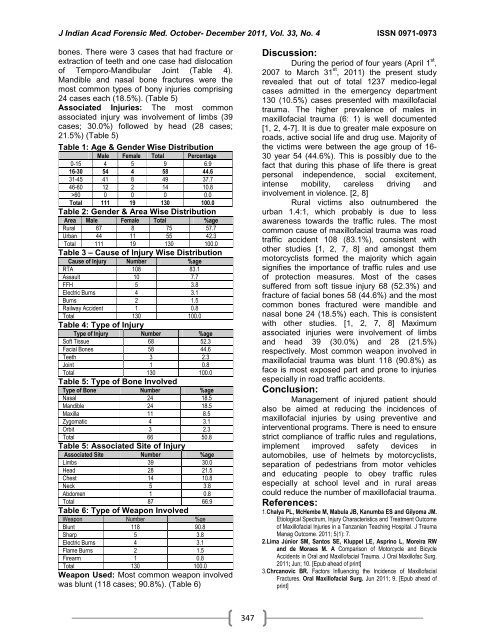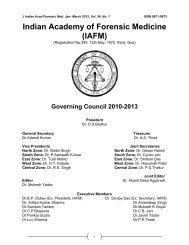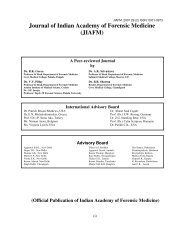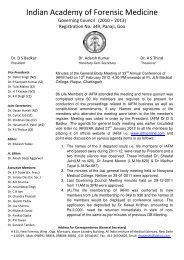Indian Academy of Forensic Medicine (IAFM) - Official website of IAFM
Indian Academy of Forensic Medicine (IAFM) - Official website of IAFM
Indian Academy of Forensic Medicine (IAFM) - Official website of IAFM
You also want an ePaper? Increase the reach of your titles
YUMPU automatically turns print PDFs into web optimized ePapers that Google loves.
J <strong>Indian</strong> Acad <strong>Forensic</strong> Med. October- December 2011, Vol. 33, No. 4 ISSN 0971-0973<br />
bones. There were 3 cases that had fracture or<br />
extraction <strong>of</strong> teeth and one case had dislocation<br />
<strong>of</strong> Temporo-Mandibular Joint (Table 4).<br />
Mandible and nasal bone fractures were the<br />
most common types <strong>of</strong> bony injuries comprising<br />
24 cases each (18.5%). (Table 5)<br />
Associated Injuries: The most common<br />
associated injury was involvement <strong>of</strong> limbs (39<br />
cases; 30.0%) followed by head (28 cases;<br />
21.5%) (Table 5)<br />
Table 1: Age & Gender Wise Distribution<br />
Male Female Total Percentage<br />
0-15 4 5 9 6.9<br />
16-30 54 4 58 44.6<br />
31-45 41 8 49 37.7<br />
46-60 12 2 14 10.8<br />
>60 0 0 0 0.0<br />
Total 111 19 130 100.0<br />
Table 2: Gender & Area Wise Distribution<br />
Area Male Female Total %age<br />
Rural 67 8 75 57.7<br />
Urban 44 11 55 42.3<br />
Total 111 19 130 100.0<br />
Table 3 – Cause <strong>of</strong> Injury Wise Distribution<br />
Cause <strong>of</strong> Injury Number %age<br />
RTA 108 83.1<br />
Assault 10 7.7<br />
FFH 5 3.8<br />
Electric Burns 4 3.1<br />
Burns 2 1.5<br />
Railway Accident 1 0.8<br />
Total 130 100.0<br />
Table 4: Type <strong>of</strong> Injury<br />
Type <strong>of</strong> Injury Number %age<br />
S<strong>of</strong>t Tissue 68 52.3<br />
Facial Bones 58 44.6<br />
Teeth 3 2.3<br />
Joint 1 0.8<br />
Total 130 100.0<br />
Table 5: Type <strong>of</strong> Bone Involved<br />
Type <strong>of</strong> Bone Number %age<br />
Nasal 24 18.5<br />
Mandible 24 18.5<br />
Maxilla 11 8.5<br />
Zygomatic 4 3.1<br />
Orbit 3 2.3<br />
Total 66 50.8<br />
Table 5: Associated Site <strong>of</strong> Injury<br />
Associated Site Number %age<br />
Limbs 39 30.0<br />
Head 28 21.5<br />
Chest 14 10.8<br />
Neck 5 3.8<br />
Abdomen 1 0.8<br />
Total 87 66.9<br />
Table 6: Type <strong>of</strong> Weapon Involved<br />
Weapon Number %ge<br />
Blunt 118 90.8<br />
Sharp 5 3.8<br />
Electric Burns 4 3.1<br />
Flame Burns 2 1.5<br />
Firearm 1 0.8<br />
Total 130 100.0<br />
Weapon Used: Most common weapon involved<br />
was blunt (118 cases; 90.8%). (Table 6)<br />
347<br />
Discussion:<br />
During the period <strong>of</strong> four years (April 1 st ,<br />
2007 to March 31 st , 2011) the present study<br />
revealed that out <strong>of</strong> total 1237 medico-legal<br />
cases admitted in the emergency department<br />
130 (10.5%) cases presented with maxill<strong>of</strong>acial<br />
trauma. The higher prevalence <strong>of</strong> males in<br />
maxill<strong>of</strong>acial trauma (6: 1) is well documented<br />
[1, 2, 4-7]. It is due to greater male exposure on<br />
roads, active social life and drug use. Majority <strong>of</strong><br />
the victims were between the age group <strong>of</strong> 16-<br />
30 year 54 (44.6%). This is possibly due to the<br />
fact that during this phase <strong>of</strong> life there is great<br />
personal independence, social excitement,<br />
intense mobility, careless driving and<br />
involvement in violence. [2, 8]<br />
Rural victims also outnumbered the<br />
urban 1.4:1, which probably is due to less<br />
awareness towards the traffic rules. The most<br />
common cause <strong>of</strong> maxill<strong>of</strong>acial trauma was road<br />
traffic accident 108 (83.1%), consistent with<br />
other studies [1, 2, 7, 8] and amongst them<br />
motorcyclists formed the majority which again<br />
signifies the importance <strong>of</strong> traffic rules and use<br />
<strong>of</strong> protection measures. Most <strong>of</strong> the cases<br />
suffered from s<strong>of</strong>t tissue injury 68 (52.3%) and<br />
fracture <strong>of</strong> facial bones 58 (44.6%) and the most<br />
common bones fractured were mandible and<br />
nasal bone 24 (18.5%) each. This is consistent<br />
with other studies. [1, 2, 7, 8] Maximum<br />
associated injuries were involvement <strong>of</strong> limbs<br />
and head 39 (30.0%) and 28 (21.5%)<br />
respectively. Most common weapon involved in<br />
maxill<strong>of</strong>acial trauma was blunt 118 (90.8%) as<br />
face is most exposed part and prone to injuries<br />
especially in road traffic accidents.<br />
Conclusion:<br />
Management <strong>of</strong> injured patient should<br />
also be aimed at reducing the incidences <strong>of</strong><br />
maxill<strong>of</strong>acial injuries by using preventive and<br />
interventional programs. There is need to ensure<br />
strict compliance <strong>of</strong> traffic rules and regulations,<br />
implement improved safety devices in<br />
automobiles, use <strong>of</strong> helmets by motorcyclists,<br />
separation <strong>of</strong> pedestrians from motor vehicles<br />
and educating people to obey traffic rules<br />
especially at school level and in rural areas<br />
could reduce the number <strong>of</strong> maxill<strong>of</strong>acial trauma.<br />
References:<br />
1. Chalya PL, McHembe M, Mabula JB, Kanumba ES and Gilyoma JM.<br />
Etiological Spectrum, Injury Characteristics and Treatment Outcome<br />
<strong>of</strong> Maxill<strong>of</strong>acial Injuries in a Tanzanian Teaching Hospital. J Trauma<br />
Manag Outcome. 2011; 5(1): 7.<br />
2. Lima Júnior SM, Santos SE, Kluppel LE, Asprino L, Moreira RW<br />
and de Moraes M. A Comparison <strong>of</strong> Motorcycle and Bicycle<br />
Accidents in Oral and Maxill<strong>of</strong>acial Trauma. J Oral Maxill<strong>of</strong>ac Surg.<br />
2011; Jun; 10. [Epub ahead <strong>of</strong> print]<br />
3. Chrcanovic BR. Factors Influencing the Incidence <strong>of</strong> Maxill<strong>of</strong>acial<br />
Fractures. Oral Maxill<strong>of</strong>acial Surg. Jun 2011; 9. [Epub ahead <strong>of</strong><br />
print]









